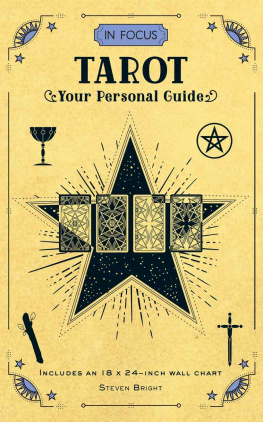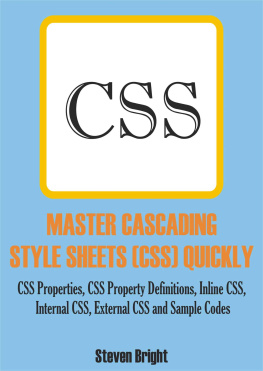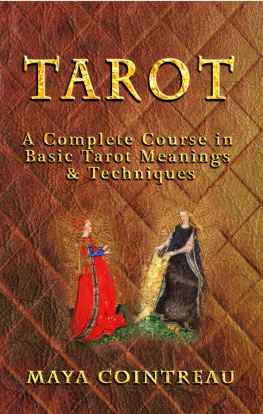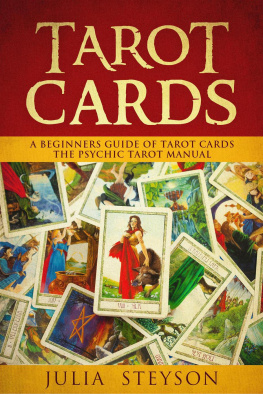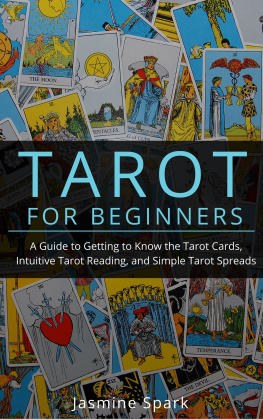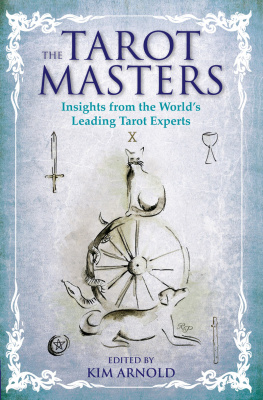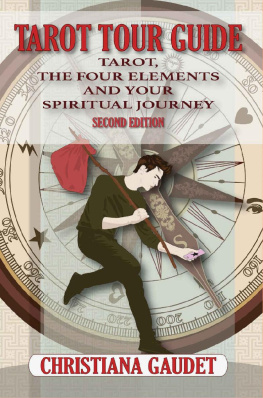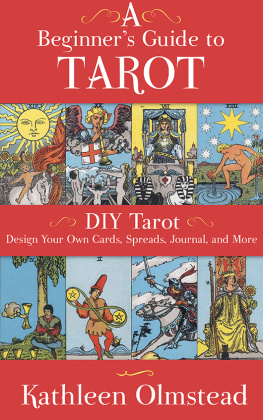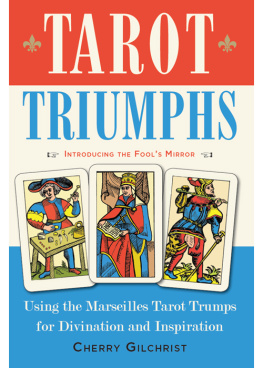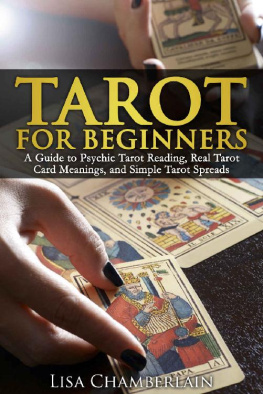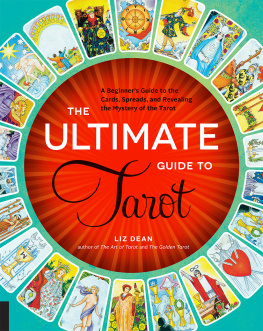Steven Bright - In Focus Tarot
Here you can read online Steven Bright - In Focus Tarot full text of the book (entire story) in english for free. Download pdf and epub, get meaning, cover and reviews about this ebook. year: 2018, publisher: Wellfleet Press, genre: Home and family. Description of the work, (preface) as well as reviews are available. Best literature library LitArk.com created for fans of good reading and offers a wide selection of genres:
Romance novel
Science fiction
Adventure
Detective
Science
History
Home and family
Prose
Art
Politics
Computer
Non-fiction
Religion
Business
Children
Humor
Choose a favorite category and find really read worthwhile books. Enjoy immersion in the world of imagination, feel the emotions of the characters or learn something new for yourself, make an fascinating discovery.
- Book:In Focus Tarot
- Author:
- Publisher:Wellfleet Press
- Genre:
- Year:2018
- Rating:5 / 5
- Favourites:Add to favourites
- Your mark:
- 100
- 1
- 2
- 3
- 4
- 5
In Focus Tarot: summary, description and annotation
We offer to read an annotation, description, summary or preface (depends on what the author of the book "In Focus Tarot" wrote himself). If you haven't found the necessary information about the book — write in the comments, we will try to find it.
In Focus Tarot — read online for free the complete book (whole text) full work
Below is the text of the book, divided by pages. System saving the place of the last page read, allows you to conveniently read the book "In Focus Tarot" online for free, without having to search again every time where you left off. Put a bookmark, and you can go to the page where you finished reading at any time.
Font size:
Interval:
Bookmark:

CHAPTER ONE
Getting Started
CHAPTER TWO
The Major Arcana
CHAPTER THREE
The Minor Arcana
CHAPTER FOUR
Becoming Adept & Spreads

The tarot that we recognize today is a set of seventy-eight illustrated cards. Whether you have used tarot before or not, youre probably aware of a few of its main players. Most people will call to mind the enigmatic Death card whenever the tarot is mentioned. If not Death, then it might be The Lovers, since both cards have been used many times in fiction and popular culture. There are, however, seventy-six additional cards, probably less recognizable, that make up a standard tarot pack. You might be surprised to know that Death and The Lovers are less frequent visitors to a readers table than they appear in the pages of novels or in television dramas!
Tarot has a shady history, and for that reason, we will not look into it too deeply here. There have been many conflicting theories as to how and when it originated, but most modern tarot commentators settle on Renaissance Italy as being the time and place that tarot made its public debut. The oldest and most complete deck in existence is the Visconti-Sforza, dating back to the fifteenth century, the cards of which now rest in museums and with collectors around the world.
What is known about tarot is that it has ducked in and out of fashion throughout history, being damned by the church in the second half of the fourteenth century, resurrected by the occultists in the late nineteenth century, and adopted by the New Age community not long after. Tarots traditional meanings have evolved, as has its style and use. These days, tarot cards are used for far more than they ever were previously, and they provide counsel and comfort for people the world over. Tarots use as an aid for reflection, healing, and psychological analysis is popular, as is its use within magical work and for fortune telling.
Tarot can help us unlock our deepest feelings, confront our fears, and successfully guide us through the darker aspects of life. Whether used for daily affirmations or to gauge the next best step, most would agree that the real power of the tarot is not within the cards themselvessince they are no more than paper and inkbut within the intention of the users and how they interpret these symbols for the best good. Tarot must not rob us of our personal power and capabilities but, instead, should empower and help us to live a richer life. The cards can do this by showing readers how to tap in to potential opportunities, providing them with ways we can effectively swerve around or confront the obstacles on our path.
While tarot can help us to decipher problems and unlock obstacles, it is most effectively used when concentrating on the present time. While it can locate issues that have played an important part in our past or that will have a significant bearing on the future, it is worth remembering that our future is not set in stone. The tarot cards are best used as a tool to help provoke changes, rather than seal our future with uncompromising fate. Not everyone realizes this when they receive a reading. A common misconception of tarot is that it predicts an unyielding future that we have no control over.
While the cards will accurately pinpoint relevant situations, they are not a replacement for medical advice. When in a state of ill health, many will consult a reader, hoping that theyll receive the all clear in the cards. Although the tarot can often detect when something is wrong, it cannot advise a solution for a medical problem. While this might seem obvious, youd be surprised how many seek answers around health in a tarot reading. Someone seeking medical guidance should speak to a doctor before consulting a tarot reader. The tarot may help you deal with a health-related problem emotionally, but it cannot diagnose what is wrong or suggest the best treatment.
Many people believe that tarot is part of the practice of witchcraft or is a replacement for religion. These are also false beliefs. While many practicing witches use tarot, it is not synonymous with either witchcraft or Wicca. Tarot is used by people of all religions and by those with no religious affinity. For most, it is a tool to help them enhance their spiritual beliefs, rather than acting as a replacement for it.
It is important to acknowledge, right at the beginning of this book, that tarot is not dangerous. This is something that some believe, but it is far from the truth. Religion and popular media have instilled fear within the minds and hearts of many, muddying the good work and reputation of many skilled readers.

Think for a second, if you would, of the humble knife. Most of us pick one up every day, whether to butter our bread or to cut food. However, youd probably not be surprised to hear that the most common knives used in assaults are ones taken from the kitchen. Should we brand all knives as murder weapons? Of course we shouldnt. A knife is only a weapon if determined so by the person using it.
It would be fair to say that not everyone uses the tarot cards with positive intention. While the cards may have less potential to physically harm than a knife, some are fearful of the tarot and think that using it could be dangerous. As with the example of the kitchen knife, this can only be determined by the user. There will always be people who choose to use their tools to appear powerful or as a way of controlling others. But when used with sensitivity, compassion, and responsibility, the wealth of the tarot images and their meanings can be sought to find peace and direction. As we will discover, the seemingly darker images within the seventy-eight-card decklike those of Death and The Devilare simply reflections of our own motivations and aspects of our life journey. In many cases, these symbols neednt be feared but embraced. Life is not entirely positive or entirely negative. The tarot deck reflects this and seeks to establish a sense of balance.
Some tarot designers have sought to provide decks with overtly positive depictions on the cards. It would be true to say that no card in the tarot deck is entirely light or entirely dark, but sweeping anything that is seemingly worrying under the spiritual carpet is not a reflection of the human experience. We all face difficulties and obstacles. It is a fact of life. It is the way in which we respond to these events that is important. Do we confront them, or do we try to hide from them?
The short answer to this is: anyone.
Contrary to common belief, you do not need to have psychic skills to read the cards, nor need you be part of a certain group, or hold a specific set of spiritual beliefs. If we have a positive intention and an open mind, the tarot cards are an effective tool for delving deeper into our intuition and unconscious motivations. Working like a mirror, the cards reflect not only what is happening, but also those things of which we might not be consciously aware at the present time.
We all learn differently, so how you gain the most from this book will be individual to you. That said, the book has been set up with both the beginner and intermediate reader in mind. For the tarot newcomer, it can be read from cover to cover, but it is likely that most tarot students will wish to use it as a resource that they can dip in and out of.
Font size:
Interval:
Bookmark:
Similar books «In Focus Tarot»
Look at similar books to In Focus Tarot. We have selected literature similar in name and meaning in the hope of providing readers with more options to find new, interesting, not yet read works.
Discussion, reviews of the book In Focus Tarot and just readers' own opinions. Leave your comments, write what you think about the work, its meaning or the main characters. Specify what exactly you liked and what you didn't like, and why you think so.

